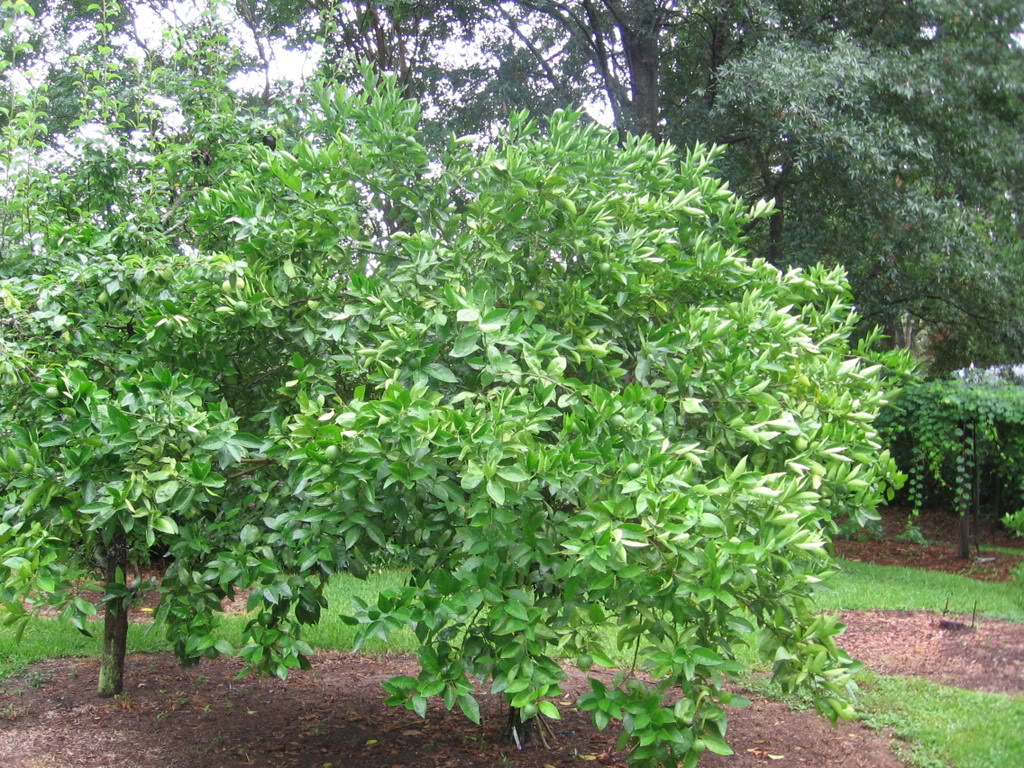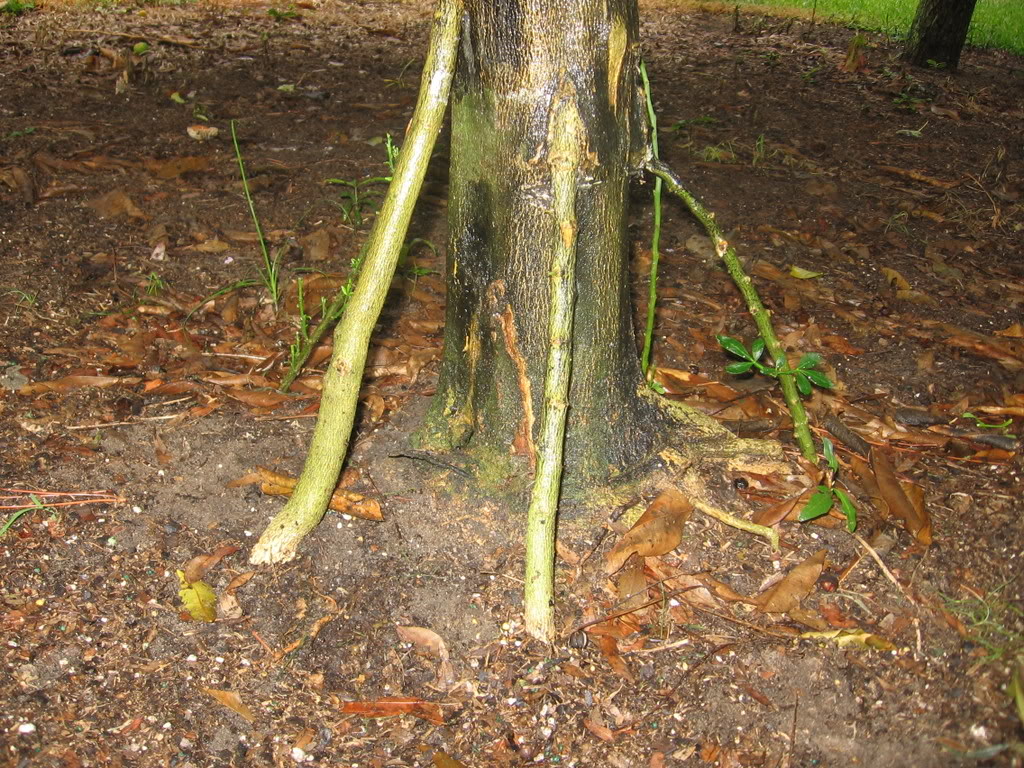 |
Citrus Growers Forum
This is the read-only version of the Citrus Growers Forum.
Breaking news: the Citrus Growers Forum is reborn from its ashes!
Citrus Growers v2.0
|
|
|
|
Plants have deep rooted family values.
|
| Author |
Message |
JoeReal
Site Admin


Joined: 16 Nov 2005
Posts: 4726
Location: Davis, California
|
| Posted: Sun 17 Jun, 2007 10:41 am |
|
http://www.msnbc.msn.com/id/19248266/
Plants Recognize Siblings
By Andrea Thompson, LiveScience Staff Writer
posted: 14 June 2007 08:53 am ET
Plants can recognize when they are potted with their siblings or with strangers, new research shows. When strangers share a pot, they develop a competitive streak, but siblings are more considerate of each other.
"The ability to recognize and favor kin is common in animals, but this is the first time it has been shown in plants," said Susan Dudley of McMaster University in Canada.
After plants are potted, roots branch out to suck up water and nutrients. But when several plants of the same species are potted together, things get a little nasty: Each plant flexes its muscles, so to speak, by extending its root growth to try and snatch up valuable resources.
Unless, that is, the plants are siblingseach having come from the same mother plantin which case they become very accommodating, allowing each other ample root space.
Because the interactions between related and unrelated plants only happened when plants were in the same pot, where root space is limited, root interactions are likely what gives plants the cue that their neighbor is related.
Dudley observed this behavior in sea rocket (Cakile edentula), a member of the mustard family that is native to beaches through North America.
The findings, detailed in the June 12 issue of Biology Letters, may not come as a surprise to seasoned gardeners.
"Gardeners have known for a long time that some pairs of species get along better than others, and scientists are starting to catch up with why that happens," Dudley said. "The more we know about plants, the more complex their interactions seem to be." |
|
| Back to top |
|
 |
JoeReal
Site Admin


Joined: 16 Nov 2005
Posts: 4726
Location: Davis, California
|
| Posted: Sun 17 Jun, 2007 10:53 am |
|
One of the implications of this findings is that it supports the practice of planting different cultivars of the same clonal rootstock into the same hole if you don't know how to graft them together or to balance their growth. Of course you still would need to arrange those that are vigorous into the north orientation, the slow growing into the south and the east and west should be of intermediate vigor. But those trees would happily co-exist if rootstocks are siblings or clonal copies.
Thus many nurseries recommend such mutliple in one tree practices, but the main caveat there is that the rootstocks should be the same clonal materials or if seedlings, must come from the same parents. Nurseries have been favoring this for obvious reasons of selling more trees, and homegrowers with limited land and don't want to dabble with grafting, would have more choices and even prolonged harvests by using cultivars with staggered harvesting dates.
I have tried planting multiple trees in one hole, which happen to be the same clonal rootstocks, just to try it out and see if they really work. Well, 7 years later, those trees are of the same vigor, have the same sized trunks, coexisting in hole, behaving like one regular sized tree, but with different cultivars. So it worked in my yard.
But it is only a couple of days ago that I found scientific proof that supported the technique of planting multiple trees in one hole. But don't forget that the rootstocks should either be siblings or clonal copies. For example, do not plant cultivars with different rootstocks into one hole, so it is important to know your rootstocks. Unfortunately, big box stores employees knew nothing about specific rootstock types, and no clue if those rootstocks are clonal or came from the same batch of seeds from the same tree. |
|
| Back to top |
|
 |
JoeReal
Site Admin


Joined: 16 Nov 2005
Posts: 4726
Location: Davis, California
|
| Posted: Sun 17 Jun, 2007 11:11 am |
|
On another extreme example of perhaps applying the same sibling cooperation and non-sibling competition is that of a very "novel" method of double rootstock grafting practiced by some Nursery growers in the Philippines. A double or triple rootstock grafting meant literally to use different kinds of rootstocks unto one scionwood!
It may involve several steps, but ultimately, the scionwood cultivar would have two or more types of rootstocks. Well, in the Philippines, Filipinos have plenty of time to dabble around that the cost of grafting is well below the cost of the whole tree, and so in the US and perhaps Europe, this would be impractical because of the time and labor involved. Almost similar approach to the time-consuming inarching method. But in some cultivars like mangoes and avocadoes, double rootstock grafting can be done in one shot, because you can use bigger scionwood.
Aside from the time and grafting labor, there are some distinct advantages of this approach if the rootstocks used are of different cultivars. One is that such rootstocks, and the whole tree itself would have more adaptability to a wider range of climatic and soil types. When one rootstock type would fail, the other one may thrive. Another is that when soil condition changes or the weather pattern changes year to year, we are supposed to have much more reliability with multiple rootstocks.
Multiple rootstocks have also been practiced here in the US, perhaps you are just unaware of it, because the way these are implemented unintentionally. Examples of such are when the trees have been girdled by animals, you can plant rootstock around the girdled tree and then would do inarching or bridge grafting to save the tree, and thus technically you would have multiple rootstocks for a single tree.
Based on theory, when two non-sibling plants are planted together in one hole so that their roots come in contact, they would try to flex their resources to reach out the prime space within the same soil, so that whoever will dominate first, will be assured of long term success in the same piece of soil. Then this is reflected back into their above ground growth. Whoever has more established roots occupying the prime spot will be able to invest more in reaching out for the sun dominating the space. So the other one will be outcompeted with another.
Now what happens if those two non-sibling plants are grafted unto one scionwood. Of course, they would still flex to outcompete each other in terms of soil space acquisition, but something here is different in that now they support only one plant which in turn support them. What happens here is that we have much more vigorous root system when two non-sibling rootstocks are used, and thus are more likely to have better supply of nutrients to the same scionwood. This is in addition to the perceived advantages of having wider adaptability and hence reliability if rootstocks of different parents are used.
It would be quite interesting to try out different rootstock cultivars into one scionwood in citruses just for the sake of curiosity. One should really try in order to find out, and perhaps test such kinds of trees across varying climate and soil types. One could still be skeptical in the armchair theories, but it is the doers who would find out first hand why theories work or not when actual tinkering are done. |
|
| Back to top |
|
 |
Millet
Citruholic


Joined: 13 Nov 2005
Posts: 6657
Location: Colorado
|
| Posted: Sun 17 Jun, 2007 5:13 pm |
|
A couple years ago I purchased a neighboring farm that bordered on south of me. The previous owner had planted a green leafed plum and a red leafed plum in the same hole. They would of course not be related due to the different leaf color. However, they have both grown to be the same size trees. A somewhat related article I read a while back entitled "Do Trees Communicate", told about how a tree releases a hormonal substance to it neighboring trees, when it is attached with an infestation, pruned or cut down. Interesting article, however if the lumber jack moved to the next tree I don't know what the neighboring tree could do about it. Perhaps, the other tree could build up some type of additional defense against the insects if they came its way. - Millet |
|
| Back to top |
|
 |
JoeReal
Site Admin


Joined: 16 Nov 2005
Posts: 4726
Location: Davis, California
|
| Posted: Sun 17 Jun, 2007 10:02 pm |
|
Millet, that is good observation. Sometimes they compete extremely, and sometimes would cooperate, or sometimes it is a draw. It depends on species to species interaction. We have symbiotic relationship between plants, and others are parasitic. Most time if they are not from the same parents, competition is the norm. |
|
| Back to top |
|
 |
Ned
Citrus Guru

Joined: 14 Nov 2005
Posts: 999
Location: Port Royal, SC (Zone 8b)
|
| Posted: Wed 20 Jun, 2007 9:36 pm |
|
Thanks Joe, very interesting.
Some years back, I was given some Ambersweet budwood, which, having no other rootstock at the time, I grafted on an orange seedling. It did quite well for awhile, but after the trunk was bumped by a young lawnmower operator a couple of times, developed collar rot. It got to looking chlorotic , so I decided to try inarching some small rootstock to it, in and attempt to save the tree. I used several varieties of rootstock in the process. The result was that the tree is now quit healthy and has a good crop of oranges. In fact, I have been thinking that the tree looks healthier as a result of the inarched rootstock. I was wondering if the use of different rootstocks might have provided a nutritional advantage for the tree. It will be interesting to watch this tree develop. I got the inarching idea after seeing pictures of the old Washington Naval orange in California, which was save by inarching young rootstock to it.
Here are a few pics of my tree.

 |
|
| Back to top |
|
 |
Millet
Citruholic


Joined: 13 Nov 2005
Posts: 6657
Location: Colorado
|
| Posted: Wed 20 Jun, 2007 11:43 pm |
|
Ned, Citrus Joe and I visited the inarched Washington Navel Orange when we both went to California on the UCR tour. The California Washington Navel is still healthy and growing. Thanks for the pictures of your tree, you did a masterful job. - Millet |
|
| Back to top |
|
 |
Ned
Citrus Guru

Joined: 14 Nov 2005
Posts: 999
Location: Port Royal, SC (Zone 8b)
|
| Posted: Thu 21 Jun, 2007 9:11 am |
|
Thanks Millet. The UCR sounds very interesting.
Ned |
|
| Back to top |
|
 |
| Informations |
 |
Our users have posted a total of 66068 messages
We have 3235 registered members on this websites
|
| Most users ever online was 70 on Tue 30 Oct, 2012 10:12 am |
Powered by phpBB © 2001, 2005 phpBB Group
|
|

















